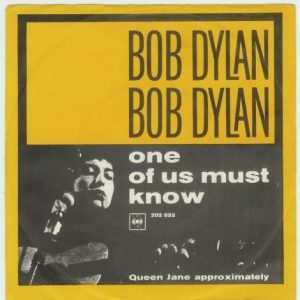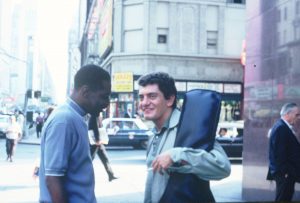One of Us Must Know (Sooner or Later) (1966)
by Jochen Markhorst
 “I always liked songs with parentheses in the title,” says host Dylan in episode 47 of his radio show Theme Time Radio Hour, at the announcement of Sonny Stitt’s “Fools Rush In (Where Angels Fear To Tread)”. These are no empty words: no less than 68 times in the 104 episodes, the radio maker chooses such a song title. And Dylan’s own catalog also contains more than twenty titles with parentheses, from “Suze (The Cough Song)” to “High Water (For Charley Patton)”. Not until the 21st century, after 2001, the grandmaster finally seems to be bored with it.
“I always liked songs with parentheses in the title,” says host Dylan in episode 47 of his radio show Theme Time Radio Hour, at the announcement of Sonny Stitt’s “Fools Rush In (Where Angels Fear To Tread)”. These are no empty words: no less than 68 times in the 104 episodes, the radio maker chooses such a song title. And Dylan’s own catalog also contains more than twenty titles with parentheses, from “Suze (The Cough Song)” to “High Water (For Charley Patton)”. Not until the 21st century, after 2001, the grandmaster finally seems to be bored with it.
But then again: the poet is not reluctant in the autobiography Chronicles (2004). On average, one pair of parentheses per ten pages, whereby he superfluously often places complete sentences in parentheses. “Okay, we were going to forget about “Dignity” for a while. (We never did go back to it.)”, for example.
Dylan does not appear to use a system. Sometimes the explanatory addition only contributes to the impenetrability, like in “Señor (Tales Of Yankee Power)” and “I’m Not There (1956)”, and sometimes it clarifies, like “High Water”, but usually a phrase from the chorus or the refrain verse is in parentheses: “I Don’t Believe You (She Acts Like We Never Have Met)” or “Coming From The Heart (The Road Is Long)”.
And “One Of Us Must Know (Sooner Or Later)” of course, Dylan’s fifth song with parentheses in the title.
It is one of his favourite songs, the master reveals in the Rolling Stone interview in 1969, and one in which, especially by Dylan standards, an exceptional amount of love has been invested. The twenty (!) attempts, rehearsals, misses and alternatives on discs 11 and 12 of the unsurpassed The Cutting Edge – Collector’s Edition (2015) illustrate this in a fascinating way. It is hardly surprising that the accompaniment changes in the course of such a session, but that the song also fans out so radically on the other fronts (lyrics, melody, tempo) is an eye-opener.
The studio talk, especially in the first two rehearsals, reveals intimate details about the creative process. Apparently Dylan has already had a first pre-rehearsal with Al Kooper. He searches his notes, finds them again, asks for help (presumably from the piano-playing Kooper) “How is the chorus?”, sings along a few words that will disappear later (“I’m glad it’s through, you’re mad it’s through”) and then interrupts: “That’s not right, Al. I don’t get it.”
Kooper answers something unintelligible, Dylan asks “What’s the tempo?” and then starts, quite slowly, with the groundwork of the first verse as we know it: “I didn’t mean to hurt you so bad.”
Hardly arrived at the chorus, Dylan interrupts once more, and again addresses Kooper: “Are you sure we played it at that tempo?”
It should be even slower… The first four lines now take 47 seconds. For comparison: in the final, 24th take, this first verse is played eleven seconds faster, in three-quarters of the original time.
It is compelling and almost blatantly voyeuristic, as close as the listener is to the process of creation.
At the sixth rehearsal, Dylan is still having doubts: “Is that the way it was?’, the song then seems to slide into its final form, the thin wild mercury sound even sparks for a moment, but disappears again at rehearsal no. 9. The maestro hears that too. “I don’t think that’s the right way. You think so? I think we ought to do it quieter.”
Around that time, the playing of pianist Paul Griffin starts to shine – the magical, final piano part is still a long way off, but the contours are starting to get clear. Griffin (1937-2000) can basically go as he pleases and may, at his own discretion, tinker with his keyboard playing that, as the hours pass, culminates in an enchanting mix of shyness, threat, drama and allure. Critic Jonathan Singer puts it better: “Half Gershwin, half gospel, all heart”, and Al Kooper lacks superlatives to honour “probably Paul Griffin’s finest moment.”
At the moment, January 1966, Griffin is already a musician’s musician – the connoisseurs have known him since the late 1950s. He has played on a whole series of (mostly soul) hits, even gifted keyboard player Burt Bacharach gets up from his piano stool to let Griffin play with his Dionne Warwick or a Chuck Jackson (the striking organ part in “Any Day Now” is Griffin), Solomon Burke considers him his own private keyboard player and Dylan already knows him from the idiosyncratic strolling and hopping on “Like A Rolling Stone” and “Just Like Tom Thumb’s Blues”.
But Kooper is right: “One Of Us Must Know” inspires him to his very best moments. In the following years, Griffin occasionally comes close to this peak. His contribution to Van Morrison’s masterpiece Astral Weeks (1968), the work he provides for Steely Dan (especially on “Peg”, from the album Aja, 1977) and the supporting part and the distinctive frills on Don McLean’s world hit “American Pie” (1971).
And while Dylan seeks tempo, melody and orchestration, he continues to work on the lyrics. Quite radically, too – nothing of the original chorus is maintained:
Now you’re glad it’s through
And I’m feeling so mad
Now that I let you cry
I didn’t mean to hurt you so bad
… is one of the early variants. Although the couplets change less drastically, but still effortlessly enough to put an end to the fairly broad belief that the text is anecdotal.
The cooled down lover Dylan here dumps Warhols Beauty No. 2, Edie Sedgwick, that is the most popular interpretation. For a biographical, anecdotal interpretation a few facts speak, that much is true. Certainly compared to the surrounding songs on Blonde On Blonde, it is an unusually dry, unadorned monologue, with no inscrutable secondary characters like those shady doctors, preachers or jelly-faced women. Even the rare, potentially ambiguous passages (the scarf that hides the mouth, the blinding snow) may symbolize emotional cold and social discomfort, but are in fact so little weird that they might actually be real remembered images.
The relative transparency of the words allows the assumption that the poet stays close to home, in any case. And indeed, the poet has achieved rock-divine status in recent months, with the subsequent overdose of attention from excited girls and teenage fanatics without sense of perspective. An amalgam of those groupies then becomes the you in this song and gets discarded by the protagonist. Recognizable are the clumsy clichés like “I understand you so well”, the immediate, total surrender at the first meeting with the idol and the awkward embarrassment of His Worship (“I didn’t realize how young you were”), who sober and cruel diminishes: “You just happened to be there, that’s all.”
Anyway: it is a beautiful song and it is rightly being released as a single. After the mega hit “Like A Rolling Stone”, “Can You Please Crawl Out Your Window?” did flop. Now “One Of Us Must Know” should make advantage of the momentum and yield Dylan another hit.
That doesn’t work, strangely enough. The single does nothing in the US, grazes the charts in Europe. The artist seems to be bothered by that, just like he is later, with the debacle of “Baby, Stop Crying”: the song disappears from his setlist for years and only after flattering sales pitches by sympathetic fans like the journalist Larry Sloman, it is picked up again – in 1976, ten years later.
Others have fewer reserves, but rarely know how to capture the beauty within. The Boo Radleys produce an original but tiring mix of trash and stillness on the tribute album Outlaw Blues (1992), the singer of Simply Red, Mick Hucknall, keeps it safe and pleasant (Chimes Of Freedom, 2012) and the Dutch rockers and Dylan adepts Jan Barten and Fons Havermans are doing quite well, but no more than that.
The two covers that still stand out somewhat can also be found on tribute albums. One on Blues On Blonde On Blonde from 2003. Clarence Bucaro, an otherwise rather mediocre singer-songwriter from Brooklyn, opts for a roaring twenties arrangement, with clarinet, upright bass and acoustic jazz guitar, thus giving a nice nostalgic and melancholic touch to one of Dylan’s inexorable masterpieces.
The most attractive cover, by far, is on Mojo’s 2016 Blonde On Blonde Revisited tribute, on the occasion of the monument’s fiftieth anniversary, by veteran Chip Taylor.
The seventy-six year old legend starts the song as an American Recording by Johnny Cash; talk-singing over a wavering guitar. A bit later on, the song is sparsely dressed up with a modest, mercury organ, then a discreet bass, light accompaniment on the floor tom and a goosebump-inducing second voice. The old-fashioned mellotron in the background, halfway through, is particularly elegant.
It is a wonderful rendition by an oldtimer who should have gotten his place in the Rock & Roll Hall Of Fame a long time ago – not only did Chip Taylor write “Angel Of The Morning” and “Son Of A Rotten Gambler”, but most of all: he is the writer of the indestructible classic “Wild Thing”. And from that other monument with parentheses in the title, Janis Joplin’s “Try (Just A Little Bit Harder)”.
Chip Taylor:
What else is on the site
You’ll find an index to our latest posts arranged by themes and subjects on the home page. You can also see details of our main sections on this site at the top of this page under the picture.
The index to the 500+ Dylan compositions reviewed is now on a new page of its own. You will find it here. It contains reviews of every Dylan composition that we can find a recording of – if you know of anything we have missed please do write in.
We also have a discussion group “Untold Dylan” on Facebook. Just type the phrase “Untold Dylan” in, on your Facebook page or follow this link
And please do note The Bob Dylan Project, which lists every Dylan song in alphabetical order, and has links to licensed recordings and performances by Dylan and by other artists, is starting to link back to our reviews.



We are actively promoting a link to this interesting topic on The Bob Dylan Project at:
https://thebobdylanproject.com/Song/id/474/One-of-Us-Must-Know-Sooner-or-Later
If you are interested, we are a portal to all the great information related to this topic.
Join us inside Bob Dylan Music Box.